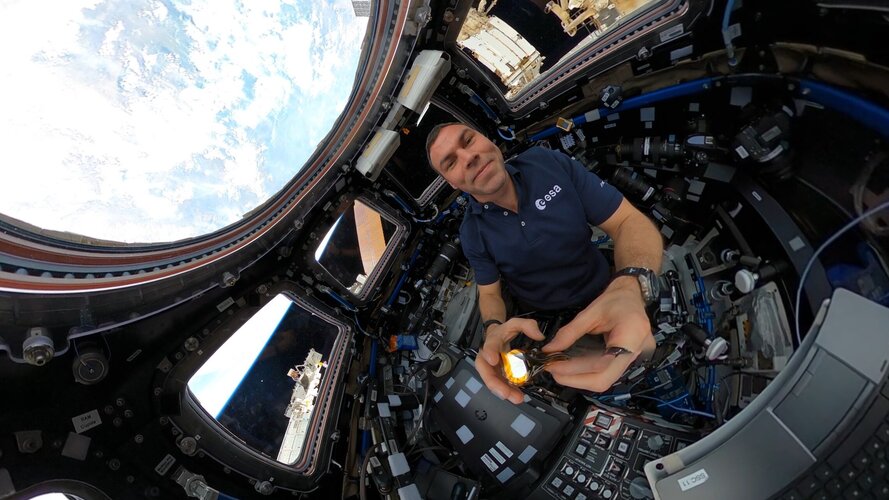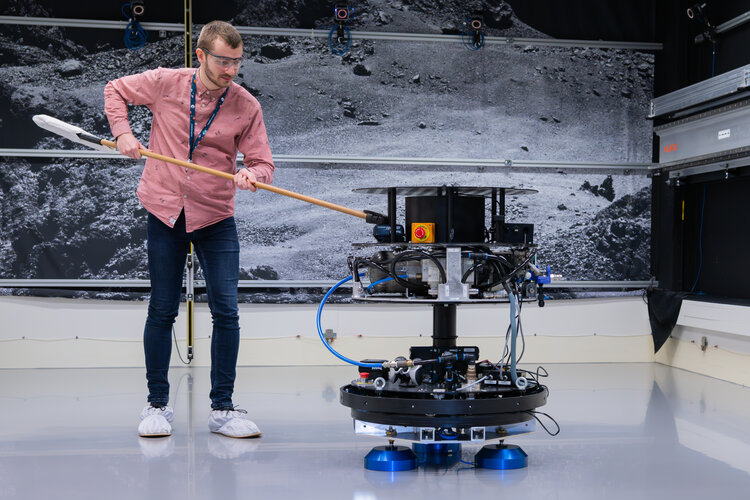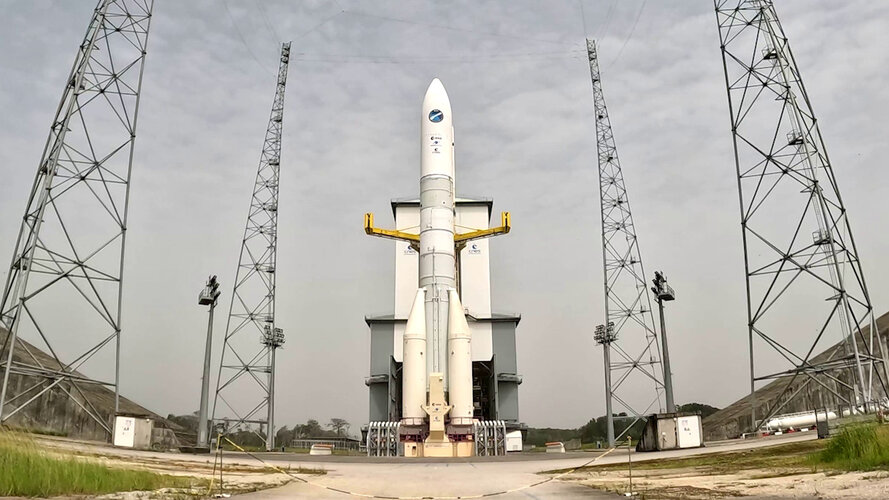
Copernical Team
Cupola in 360° – Muninn
 Video:
00:00:36
Video:
00:00:36
Join ESA project astronaut Marcus Wandt inside the seven-windowed cupola, the International Space Station's "window to the world" and and pan around to enjoy the view.
The ESA - European Space Agency-built Cupola is the favourite place of many astronauts on the International Space Station. It serves not only as a unique photo spot, but also for observing robotic activities, arriving spacecraft and spacewalks.
Marcus was launched to the International Space Station on the Dragon spacecraft as part of Axiom Mission 3 on 18 January 2024. His two-week mission on board is known as Muninn.
Follow Marcus’s journey on the
Human vs. hover-machine
 Image:
Human vs. hover-machine
Image:
Human vs. hover-machine ESA’s cloud mission in the limelight

Dedicated to delivering a wealth of new information on exactly how clouds and aerosols affect Earth’s climate, ESA’s EarthCARE satellite has had the chance to show off prior to engineers embarking upon the careful task of packing it up for its journey to the launch site in the US.
XMM-Newton spots a black hole throwing a tantrum

Black holes are like temperamental toddlers. They spill food all the time, but ESA’s XMM-Newton has caught a black hole in the act of ‘flipping over the table’ during an otherwise civilised meal.
This act prevents the galaxy surrounding the black hole from forming new stars, giving us insight into how black holes and galaxies co-evolve.
Ariane 6 test model cryogenic system disconnection
 Video:
00:01:18
Video:
00:01:18
Teams from ESA, France’s space agency CNES and ArianeGroup successfully completed the disconnection and retraction of the Ariane 6 cryogenic systems on 30 January 2024.
These operations mark the start of dismantling the Ariane 6 test model to make way for its first launch. The combined test phase for Ariane 6 using propellants is now over and the European rocket is on track for its inaugural launch.
The test model that is on the launch pad at Europe’s Spaceport in Kourou, French Guiana, stands 62 m high. It is exactly the same as the ‘production model’ Ariane 6 rockets
How the 2024 Total Solar Eclipse Is Different than the 2017 Eclipse
 On April 8, the Moon's shadow will sweep across the United States, as millions will view a total solar eclipse. For many, preparing for this event brings memories of the magnificent total solar eclipse on Aug. 21, 2017.
In 2017, an estimated 215 million U.S. adults (88% of U.S. adults) viewed the solar eclipse, either directly or electronically. They experienced the Moon pass in front of t
On April 8, the Moon's shadow will sweep across the United States, as millions will view a total solar eclipse. For many, preparing for this event brings memories of the magnificent total solar eclipse on Aug. 21, 2017.
In 2017, an estimated 215 million U.S. adults (88% of U.S. adults) viewed the solar eclipse, either directly or electronically. They experienced the Moon pass in front of t China's AIMS telescope achieves unprecedented accuracy in solar observations
 In a significant advancement in solar observation, the Accurate Infrared Magnetic Field Measurements of the Sun (AIMS) telescope, a pioneering project supported by the National Natural Science Foundation of China, has reached a new milestone. Located in Lenghu township, Qinghai Province, at an elevation of approximately 4,000 meters, AIMS stands as the world's first solar magnetic-field telescop
In a significant advancement in solar observation, the Accurate Infrared Magnetic Field Measurements of the Sun (AIMS) telescope, a pioneering project supported by the National Natural Science Foundation of China, has reached a new milestone. Located in Lenghu township, Qinghai Province, at an elevation of approximately 4,000 meters, AIMS stands as the world's first solar magnetic-field telescop SpaceFund Welcomes Business Veteran Leo Rodriguez to Board
 SpaceFund, Inc., a leading player in the space venture capital arena, recently welcomed a new member to its Board of Directors - the internationally renowned business leader, Leonardo (Leo) A. Rodriguez. This addition marks a significant step in the company's journey to bolster its growth and enhance the prospects of its 21 portfolio companies.
Rodriguez, with a career spanning over four d
SpaceFund, Inc., a leading player in the space venture capital arena, recently welcomed a new member to its Board of Directors - the internationally renowned business leader, Leonardo (Leo) A. Rodriguez. This addition marks a significant step in the company's journey to bolster its growth and enhance the prospects of its 21 portfolio companies.
Rodriguez, with a career spanning over four d Zeno Power and DOE Team Up to Revitalize Radioisotope Power Technology for Strategic Domains
 Zeno Power, a pioneer in the field of radioisotope power systems (RPSs), has recently announced a significant advancement in its technology. The company has secured a supply of Strontium-90 (Sr-90) material from the U.S. Department of Energy (DOE) to fuel its initial full-scale RPSs, marking a notable milestone in the pursuit of reliable and clean energy solutions for national security and space
Zeno Power, a pioneer in the field of radioisotope power systems (RPSs), has recently announced a significant advancement in its technology. The company has secured a supply of Strontium-90 (Sr-90) material from the U.S. Department of Energy (DOE) to fuel its initial full-scale RPSs, marking a notable milestone in the pursuit of reliable and clean energy solutions for national security and space UKansas researchers awarded NSF grant to explore the Cosmic Web
 Researchers at the University of Kansas, led by Professor Gregory Rudnick of physics and astronomy, have embarked on an ambitious project to unravel the complexities of galaxy evolution. Funded by a significant $375,000 grant from the National Science Foundation (NSF), the team is set to explore the intricate relationship between galaxies and their cosmic journeys through varied environments.
Researchers at the University of Kansas, led by Professor Gregory Rudnick of physics and astronomy, have embarked on an ambitious project to unravel the complexities of galaxy evolution. Funded by a significant $375,000 grant from the National Science Foundation (NSF), the team is set to explore the intricate relationship between galaxies and their cosmic journeys through varied environments. 